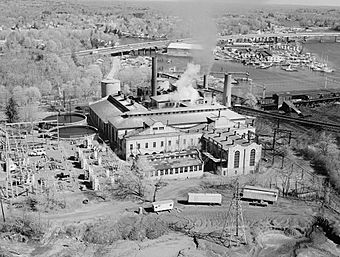Cos Cob Power Station facts for kids
Quick facts for kids |
|
|
Cos Cob Power Station
|
|

Cos Cob Power Station in 1977
|
|
| Location | Roughly bounded by Metro North RR tracks, the Mianus R. and Sound Shore Dr., Cos Cob, Greenwich, Connecticut |
|---|---|
| Area | 6 acres (2.4 ha) |
| Built | 1907 |
| Architect | Westinghouse, Church, Kerr & Co. |
| Architectural style | Mission/Spanish Revival |
| NRHP reference No. | 90001096 |
| Added to NRHP | August 2, 1990 |
The Cos Cob Power Station was a very important building in Cos Cob, Connecticut. It was a large power plant that helped run the first major electric train line in the United States. This power station used a special type of electricity called alternating current (AC).
Contents
Powering Early Electric Trains
The Cos Cob Power Station was built in 1907. It was located near the Mianus River and Long Island Sound. The building itself was designed in a beautiful style called Mission Revival.
This power station was special because it was part of the first big railroad line in the United States to use alternating current (AC) electricity. Other train systems, like the New York City subway, used direct current (DC). DC works well for short distances. But for longer train lines, AC was much better. It lost less power over long distances.
Why AC Was Chosen
In 1903, a new law in New York State said that steam trains could no longer be used in New York City. The New York, New Haven and Hartford Railroad (often called "New Haven") ran many trains into the city. They needed a new way to power their trains.
If they had to switch from steam to electric trains at the city limits, it would cause huge delays. So, the New Haven railroad decided to electrify their entire line all the way to New Haven.
They chose AC electricity, which was suggested by a company called Baldwin-Westinghouse. Their new electric trains could use DC power when they were inside New York City. But on the main line, they would switch to the more efficient AC power.
How the Plant Worked
The Westinghouse company built the Cos Cob Power Station. It was placed where the Mianus River meets Cos Cob Harbor. The plant used coal to heat water and create steam. This steam then spun large machines called turbines. These turbines generated the AC electricity.
The power station sent single-phase electricity at 11,000 volts directly to the overhead wires (called catenary) that powered the trains. It also supplied power to another station in New York City. This helped make up for the electricity used by New Haven trains on the New York Central Railroad's tracks. Those tracks used a "third-rail" DC system to get to Grand Central Terminal.
A Historic Landmark
In 1982, the Cos Cob Power Station was recognized as a Historic Mechanical Engineering Landmark. This showed how important its design and technology were for engineering history.
End of an Era
The power station stopped operating in 1986 and 1987. It was listed on the National Register of Historic Places in 1990. This meant it was recognized as a historically important building.
However, despite its historical status, the plant was torn down in 2001. Today, part of the land where the power station once stood is a public park. You can find a special plaque (a small memorial) at the nearby Cos Cob Railroad Station. This plaque remembers the important role the Cos Cob Power Station played in railroad history.




